TYPE 2 - Cooked n` Cured Sausages
Hi smoke addicts!
We haven`t heard from Tazplas, DDWaterdog, SAR, MRMatuszek, Pignout, TruckTramp, Doug, and Ottothecow. Are you folks grindin` and smilin`? Are you shy like El DuckO?

Oh, I know... we are all behind in our reading just a bit. It`s alright. Catch up when you can.
Right now let`s press on to some more information and another project. Let`s learn about curing and cooking sausage. Some types are
dried to reduce bacteria - some are
cooked. Please read the following pages by Stan Marianski, then let`s get a good discussion going about any questions that arise. Be sure to keep your notebook current and jot down any questions you have.
READING:
drying -
http://www.meatsandsausages.com/sausage-making/drying
smoking -
http://www.meatsandsausages.com/sausage ... oking-meat
cooking -
http://www.meatsandsausages.com/sausage ... oking-meat
DISCUSSION:
For the next part of B2, let`s consider casing and cooking the sausage for protection against the effects of pathogenic bacteria. If we case the sausage, we cut off oxygen. Inside a warm smoker, pathogenic bacteria have direct access to nutrient, moisture, anaerobic atmosphere, and they`re inside the temperature "danger zone" of 40-140°F. These conditions warrant the use of Cure #1 (also called Prague Powder, Instacure, Pink Salt, etc.) This is sodium nitrite on a salt carrier and it becomes a "must" in our smoked recipes.
One of the easiest to make, yet most tasty sausages of this type is the "summer" sausage - not traditionally made during the summer months, rather consumed during the summer! Later, we`ll get into the addition of bacterial cultures. For right now, we can begin to understand the effects of fermentation by observing "chance contamination" and bacterial development. Historically, the air-dried favorite has been made during the colder winter months, becoming bacteriologically stable as it dried slowly.
Post any questions that come up during the reading.
PROJECT:
As the holidays approach, you may be interested in making a few fancy-wrapped and netted "smoke-stick" sausages for gifts. Everyone likes a summer sausage, a little cheese, some home preserves, and some crackers in a basket. When I make this sausage, I like to use the 76 m.m. mahogany-colored casings(Sausagemaker #26200) filled and placed inside a dark brown plastic diamond-pattern presentation netting
(Sausagemaker #13513). Twist the netting and clamp it off using a hog-ring. Tie a fancy Christmas bow around the hog ring and you`ve got a great-looking and great-tasting gift that anyone would like to have. They are best made about 2 weeks before Christmas and kept refrigerated. Don`t fudge on the ingredients or the procedure. Follow the directions carefully and you`ll have a sausage that will help build your reputation as a craftsman.
"Sunrise Summer Sausage"
Semi-Dry-Cured Summer Sausage
6 lbs. pork butt
4 lbs. beef chuck
2 level tspns. Cure No. 1
5 tblspns. uniodized salt
4 tblspns. corn syrup solids
4 tblspns. powdered dextrose
6 oz. (170 gr.) Fermento
1-1/2 tspns. garlic powder
2 tblspn. mustard powder
1 tblspn. ground coriander
1 tspn. allspice
Separate the fat from the lean meat and cut only the fat into 3/8" dice. Place it into the freezer. Grind the lean meat through a 3/16" plate then add all the other ingredients, mixing the Prague Powder #1 with a little ice water for even distribution. Mix the lean meat until the actomyosin develops the "primary bind" and becomes tacky. Finally, add the larger diced frozen fat and carefully fold it into the meat, distributing it evenly.
Stuff the sausage into your favorite casings (see paragraph below), hang them on smokesticks, and allow them to ferment 24-48 hours at 85°; F. (29°; C.) in 90% relative humidity. I have known sausage makers, fearing spoilage, who have preferred to place the sausages inside a 38°F. cooler (at a much reduced humidity) for a period of 48 hours at this point. Note that at this lowered temperature, the activity of lactobacillus is greatly reduced, requiring more time for fermentation to take place.
Some degree of fermentation will be accomplished by the "chance contamination" of lactobacillus or pediococcus bacteria nourished by the dextrose and corn syrup solids. Note that Fermento is not a starter culture. It is simply a flavoring ingredient made from whey in the dairy industry. It gives semi-dry-cured summer sausage a proper boost of "tang" and it is produced and sold by the Sausagemaker™. It is an organic product and may be used safely.
Next, pat the sausages dry, hang them in your smoker, and introduce smoke for 5 hours, dropping the relative humidity to 70%. Gradually, increase the smokehouse temperature only a few degrees every twenty minutes or so, until they reach an internal meat temperature of 148°;F. (Any possible trichinella spiralis has been destroyed at 138°; F.). Shower the sausages with cold water until the internal meat temperature drops below 80°; F. (26°; C.). Pat them dry and allow the sausages to continue drying at 65°; F. (18°; C.), three more days in 70% humidity. Now is the time to "bite `em"! At this point, your summer sausage could possibly require "extensive taste testing", usually performed with the assistance of several stout, ice-cold, foaming, beverages. Store the sausages at 50°; F. (10°;C.) in 75% humidity.
Traditionally, sewn beef middles about two feet in length and almost 3" in diameter were used for summer sausage. I`ve had great success with 3-1/2" diameter fibrous casings cut two feet long. Placed in dark brown netting, the product is very presentable and popular as gifts. Most folks today prefer much smaller summer sausages, using 38 m. m. hog casings or mahogany-colored synthetic fibrous casings cut about a foot in length.
This is "Cervelat" summer sausage with coriander. If you wish to make "Goteborg" summer sausage, delete the coriander and substitute up to 2 tablespoons of ground nutmeg.
Best Wishes,
Chuckwagon


















